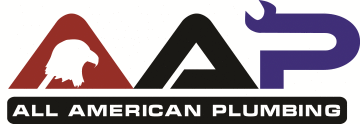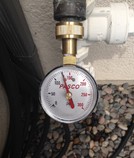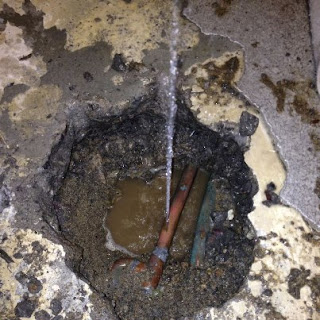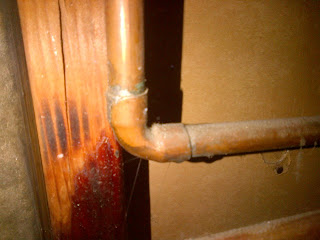AAP All American Plumbing - Serving Southern California for over 20 yrs - Plumbing and Drain Cleaning Experts
High water pressure is the #1 cause of plumbing problems. The excessive pressure causes undue wear and tear on the entire plumbing system. Pipes can burst, faucets leak,
dishwashers wear out faster as the pressure pushes the entire system to its limits.
The Uniform Plumbing Code 608.2 calls for a pressure regulator to be installed whenever the incoming water pressure exceeds 80psi. Manufactures of water heaters, toilet valves and water
softeners call for the pressure to be maintained in the 50psi range (as optimal).
You can monitor your water pressure every six months or so by way of a simple water pressure gauge test. The gauge can be picked up at your local hardware store for around
$15.00.
Simply connect the gauge to your exterior water hose spigot and turn on the water to get your reading. If the reading exceeds 80psi - it's time to repair, replace or install a water pressure
regulator.
A water pressure regulator will do just as the name implies "regulate the water pressure". New pressure regulators come preset at 50psi and can be adjusted up to 75psi ( lower is
better).
Tired of leaks? Hate calling plumbers? Do yourself a favor and stay on top of the number one cause of plumbing issues - high water pressure.
It's simple to check and highly recommended if you want to save money on plumbing repairs.
What causes plumbing problems?
Plumbing, everybody fears the plumber... The high cost, the mess, the intrusion of ones personal space. The stress involved during a plumbing problem can be enormous! Water everywhere,
sewage flowing out onto the floors or through the walls - MOLD! Ughh, mold and mildew.
Why do we hear of so many people having had some sort of plumbing disaster? LACK OF MAINTENANCE.... We take our cars for regular check ups. We check and protect our
computers. We go to the doctors for our yearly physicals. But, we don't call a plumber until its absolutely necessary - usually, when the disaster is upon us.
How can one protect the home and wallet from a plumbing disaster? Simply put, with a little bit of preventive maintenance. You see, most of all plumbing problems fall into 1 of 4
categories.
1.High Incoming Water Pressure: What is the first thing your doctor checks upon seeing you? Your blood pressure. Why? Your blood pressure
levels can directly affect your well being is so many ways. The same is true within your plumbing system. High water pressure (deemed as any pressure above 80psi) can and will destroy your plumbing
system. http://www.watts.com/pages/learnAbout/reducingValves.asp?catId=64
2.Thermal Expansion: What is thermal expansion? The best way to describe thermal expansion is - water expands when heated. Similar to what
occurs when boiling water in a tea pot. The expansion created by the steam blows the whistle. The same can occur within your plumbing system whenever the water heater is heating water and the
expansion has no where to go. http://www.watts.com/pages/learnAbout/thermalExpansion.asp?catId=64#generalinfo_plumbingcode
3.Bad Water Quality: Those hard white spots and grime surrounding your faucets, sinks and shower doors aren't a good thing. If that sort of
build up occurs within the surface of items that rarely have water on them; can you imagine what the inside of the pipes and water heater looks like? Hard water will most definitely lead to premature
failure of your faucets, dishwasher, toilets and more.http://ga.water.usgs.gov/edu/waterquality.html
4. Poor workmanship: Poor workmanship, either by way of original construction and/or previous repairs made by handymen, weekend warriors, and
the likes - to be inferior and not withstanding the local plumbing codes or better practices. It is always best to ensure good quality by way of requiring all work performed within your home or place
of business be permitted with the local governing agency. Albeit, this will not ensure or absolve one from poor workmanship - it will definitely curb 95% of it. http://www.cslb.ca.gov/consumers/hireacontractor/BuildingPermitRequirements.asp
So what does all of this mean and what must one do to protect themselves from plumbing disasters?
1. Check the incoming water pressure yearly.
2. Check for Thermal Expansion
3. Invest in the appropriate water treatment device that best suits your locale
4. Maintain a level of security by requiring your plumber to secure permits on all of your projects
http://aap-allamericanplumbing.blogspot.com/
By Anthony Pouliot
Water Leaks --- My last post explained the reasons behind leaks. What causes them and how to best protect your plumbing system from having them.
Today, I will speak on just how much water is wasted on various types of leaks.
The number one source of wasted water within the home or place of business is the toilet... Often overlooked and frequently procrastinated on. When a toilet leaks: it tends to be internal (leaking directly from the toilet tank into the bowl and down the drain) and as such, it doesn't cause any visible damage - resulting in the repair being pushed off to some other time... Down the drain goes our precious resource and your money. A leaky toilet wastes between 300 gallons (a slow leak) and 60,000 (constantly running toilet) per MONTH!
The best way to detect a leak besides visually seeing or hearing the leak - is to drop a little food coloring into the toilet tank and wait 10-15 minutes without flushing. If the water in the bowl turns color, your tank is leaking.
Leaking faucets can also increase your water bills!
Slow Leaks - 450 gallons per month
Steady Drips - 750 gallons per month
Slow Stream - 3,000 gallons per month
Steady Stream - 12,000 gallons per month
can leak at a rate of (per size of pinhole)
1/32" leak - 3,600 gals/month
1/16" leak - 10,800 gals/month
1/8" leak - 36,000 gals/month
3/16" leak - 199,000 gals/month
1/4" leak - 340,000 gals/month
|
Underground Slab Leak |
|
Leak on 1/2" copper fitting |
|
Leak on 1/2" Type M copper pipe |
|
|
|
|
Some Tell-Tale signs a leak exists...
- Water bill increase
- Gas bill increase (indicating a hot side leak)
- Hot spots on ground level floors
- Musty/Mildew smell!
- Water meter dial is rotating with no known use of water
- The constant sound of running water or a hissing noise with no known use of water.
- The sporadic sound of water running or what sounds like the toilet is filling up after its been flushed
- Luke warm or hot water coming out of the cold side tap.
The following metrics were based on the incoming water pressure being between 60-80 psi. The higher the incoming pressure the more waste...
http://aap-allamericanplumbing.blogspot.com/
By: Anthony Pouliot
24 Hr Toll Free Service
1-855-751-5021
Areas Served -
24 hr Plumbing and Drain Cleaning Service
Rancho Cucamonga Plumbing Service 91730, 91739
Corona Plumbers 92878, 92879, 92880, 92881, 92882, 92883
Plumbers in Eastvale 92880, 91752
Lake Elsinore Plumbers 92530, 92531, 92532
Moreno Valley Plumbers 92551, 92553, 92555, 92557
Murrieta Plumbers 92562, 92563
Chino Hills Plumbing Service 91709
Fontana Plumbing Service 92335
Redlands Plumbing Service 92373
Hacienda Heights Plumbing Service
City of Industry Commercial Plumber
Rowland Heights Plumbing Service
and surrounding areas









